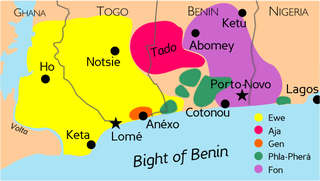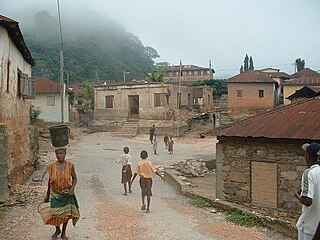
The Senufo or Senufic languages has around 15 languages spoken by the Senufo in the north of Ivory Coast, the south of Mali and the southwest of Burkina Faso. An isolated language, Nafaanra, is also spoken in the west of Ghana. The Senufo languages constitute their own branch of the Atlantic–Congo sub-family of the Niger–Congo languages. Garber (1987) estimates the total number of Senufos at some 1.5 million; the Ethnologue, based on various population estimates, counts 2.7 million. The Senufo languages are bounded to the west by Mande languages, to the south by Kwa languages, and to the north and east by Central Gur languages.

The Gur languages, also known as Central Gur or Mabia, belong to the Niger–Congo languages. They are spoken in the Sahelian and savanna regions of West Africa, namely: in most areas of Burkina Faso, and in south-central Mali, northeastern Ivory Coast, the northern halves of Ghana and Togo, northwestern Benin, and southwestern Niger. A few Gur languages are spoken in Nigeria. Additionally, a single Gur language, Baatonum, is spoken in Benin and in the extreme northwest of Nigeria. Three other single Gur languages, the Tusya, Vyemo and Tiefo languages, are spoken in Burkina Faso. Another unclassified Gur language, Miyobe, is spoken in Benin and Togo. In addition, Kulango, Loma and Lorhon, are spoken in Ghana, Ivory Coast and Burkina Faso. Additionally, a few Mossi speakers are in Senegal, and speakers of the Dagaare language are also found in Cameroon. The Samu languages of Burkina Faso are Gur languages.

The Kwa languages, often specified as New Kwa, are a proposed but as-yet-undemonstrated family of languages spoken in the south-eastern part of Ivory Coast, across southern Ghana, and in central Togo. The Kwa family belongs to the Niger-Congo phylum. The name was introduced 1895 by Gottlob Krause and derives from the word for 'people' (Kwa) in many of these languages, as illustrated by Akan names. This branch consists of around 50 different languages spoken by about 25 million people. Some of the largest Kwa languages are Ewe, Akan and Baule.
The Adele language is spoken in central eastern Ghana and central western Togo. It belongs to the geographic group of Ghana Togo Mountain languages of the Kwa branch of Niger–Congo. The speakers themselves, the Adele people, call the language Gidire.

Benue–Congo is a major branch of the Volta-Congo languages which covers most of Sub-Saharan Africa.

Mòcheno is an Upper German variety spoken in three towns of the Bersntol, in Trentino, northeastern Italy.

The Gbe languages form a cluster of about twenty related languages stretching across the area between eastern Ghana and western Nigeria. The total number of speakers of Gbe languages is between four and eight million. The most widely spoken Gbe language is Ewe, followed by Fon. The Gbe languages were traditionally placed in the Kwa branch of the Niger–Congo languages, but more recently have been classified as Volta–Niger languages. They include five major dialect clusters: Ewe, Fon, Aja, Gen (Mina), Gun and Phla–Pherá.
Pökoot is a language spoken in western Kenya and eastern Uganda by the Pokot people. Pökoot is classified to the northern branch of the Kalenjin languages found in Kenya, Uganda, and Tanzania. The Pökoot are usually called "Kimukon" by the other Kalenjin peoples. A 1994 figure of SIL puts the total number of speakers at 264,000, while the only slightly more recent Schladt (1997:40) gives the more conservative estimate of 150,000 people, presumably based on the figures found in Rottland (1982:26) who puts the number at slightly more than 115,000.
Ogiek is a Southern Nilotic language of the Kalenjin family spoken or once spoken by the Ogiek peoples, scattered groups of hunter-gatherers in Southern Kenya and Northern Tanzania. Most Ogiek speakers have assimilated to cultures of surrounding peoples: the Akie in northern Tanzania now speak Maasai and the Ogiek of Kinare, Kenya now speak Gikuyu. Ndorobo is a term considered derogatory, occasionally used to refer to various groups of hunter-gatherers in this area, including the Ogiek.
Logba is a Kwa language spoken in the south-eastern Ghana by approximately 7,500 people. The Logba people call themselves and their language Ikpana, which means ‘defenders of truth’. Logba is different from Lukpa of Togo and Benin, which is also sometimes referred to as Logba.
Yaaku is an endangered Afroasiatic language of the Cushitic branch, spoken in Kenya. Speakers are all older adults.
The Grũsi or Gurunsi languages, also known as the East Mabia languages, are a group of Gur languages, comprising about 20 languages spoken by the Gurunsi peoples. The Grũsi languages are spoken in northern Ghana, adjacent areas of Burkina Faso and Togo. The largest language in the Grusi group is Kabiye, a language spoken by approximately 1.2 million people throughout central Togo.

The Ghana–Togo Mountain languages, formerly called Togorestsprachen and Central Togo languages, form a grouping of about fourteen languages spoken in the mountains of the Ghana–Togo borderland. They are part of the Kwa branch of the Niger–Congo family.
Boro is an extinct language once spoken in central eastern Ghana. In the vicinity of Worawora and Tapa, Rudolf Plehn found one old man who could still remember some words of this language, which according to him was spoken by more people in his younger years. The language is only known from the 12 lexical items collected by Plehn around the end of the 19th century and published in Seidel (1898). Westermann (1922) classified it as one of the Togorestsprachen, a classification followed by Glottolog, while Heine (1968:300) leaves it unclassified.
Siwu is a language that is spoken in the mountainous central part of the Volta Region of Ghana. It belongs to the geographic group of Ghana Togo Mountain languages of the Kwa branch of Niger–Congo. The speakers of Siwu call themselves the Mawu and their land Kawu, some of the speakers of Siwu lives around Lolobi communite.
The Gurma languages, also known as the West Mabia languages, form part of the Oti–Volta subgroup of the Gur languages. They are spoken in eastern Burkina Faso, northern Ghana, Togo and Benin and western Niger.
The Oti–Volta languages form a subgroup of the Gur languages, comprising about 30 languages of northern Ghana, Benin, and Burkina Faso spoken by twelve million people. The most populous language is Mooré, the national language of Burkina Faso, spoken by over 55% of Burkina Faso’s 20 million population and an additional 1 million in neighboring countries such as Ghana, Ivory Coast, Niger, and Mali.

The Jukunoid languages are a branch of the Benue-Congo languages spoken by the Jukun and related peoples of Nigeria and Cameroon. They are distributed mostly throughout Taraba State, Nigeria and surrounding regions.
The Anii or Basila language is spoken in Benin, and central eastern Togo and central eastern Ghana. It is part of the geographic group of Ghana Togo Mountain languages of the Kwa branch of Niger–Congo.
The Eastern Mande languages are a branch of the Mande languages spoken in seven areas: northwest Burkina Faso, the border region of northern Benin and Nigeria, and one language, Bissa, also spoken in Ghana, Togo, and Ivory Coast and the Samo languages also spoken in Mali.








